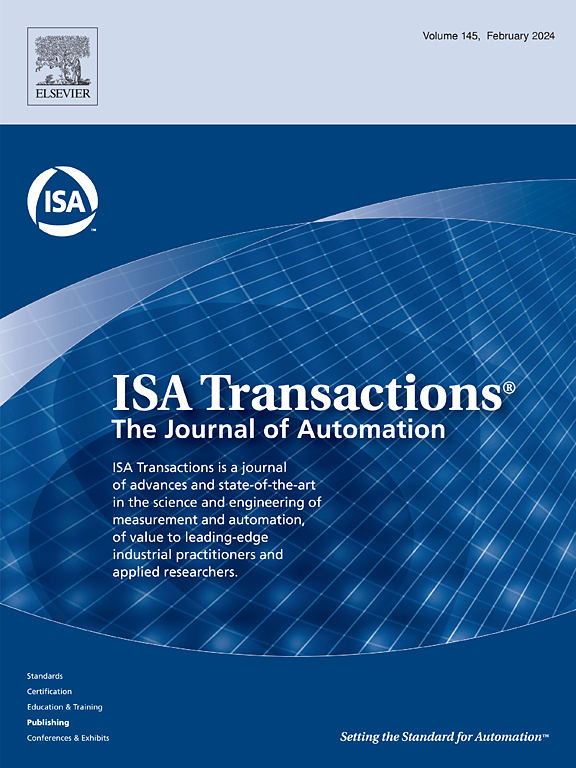时变扰动下工业自抗扰控制的最大灵敏度约束区域调谐。
IF 6.3
2区 计算机科学
Q1 AUTOMATION & CONTROL SYSTEMS
引用次数: 0
摘要
线性主动干扰抑制控制(ADRC)采用传统的卢恩贝格尔型线性扩展状态观测器(LESO)和简单的比例导数(PD)控制器来实现抗干扰应用。线性 ADRC 的局限在于无法充分抑制时变干扰。本手稿中讨论的改进型 ADRC 策略,包括基于 LESO 的比例积分导数 ADRC (LESO-PID-ADRC) 和比例谐振 ADRC (LESO-PR-ADRC),能够在有效抑制类似干扰的同时,熟练跟踪斜坡和正弦参考。此外,还提出了一种基于准广义积分器扩展状态观测器的 PID-ADRC (QGI-PID-ADRC),它能够跟踪阶跃和斜坡基准,同时抑制斜坡和正弦干扰。此外,还为 PID 和 PR 控制器提出了基于最大灵敏度约束区域 (MSCR) 的图形调谐方法。通过频域分析,说明了所设计控制器的参考跟踪和干扰抑制能力。此外,还使用奈奎斯特图说明了闭环系统的稳定性。使用 MATLAB 对两个复杂系统(船舶运动模型和压水反应堆)进行了仿真研究,这两个系统具有相关的非线性、时变系统参数和建模不确定性。研究结果表明,在使用所提出的图形方法进行调整时,LESO-PID-ADRC、QGI-PID-ADRC 和 LESO-PR-ADRC 优于最近推出的控制策略,在参考跟踪和干扰抑制方面表现出色。本文章由计算机程序翻译,如有差异,请以英文原文为准。
Maximum sensitivity constrained region based tuning of active disturbance rejection control for industrial applications in presence of time-varying disturbances
Linear active disturbance rejection control (ADRC) uses conventional Luenberger type linear extended state observer (LESO) and a simple proportional derivative (PD) controller for anti-disturbance applications. Limitation of the linear ADRC lies in its inability to adequately reject time-varying disturbances. Modified ADRC strategies discussed in this manuscript, including LESO-based proportional integral derivative-ADRC (LESO-PID-ADRC) and proportional resonant-ADRC (LESO-PR-ADRC), exhibit the capability to proficiently track ramp and sinusoidal references while effectively suppressing similar disturbances. Additionally, a quasi-generalized integrator-extended state observer based PID-ADRC (QGI-PID-ADRC) is proposed which is capable of tracking both step and ramp references while simultaneously rejecting ramp and sinusoidal disturbances. Furthermore, maximum sensitivity constrained region (MSCR) based graphical tuning approach is presented for the PID and PR controllers. Frequency domain analysis is conducted to illustrate reference tracking and disturbance rejection capability of the designed controllers. Moreover, stability of the closed loop system is illustrated using Nyquist plots. Simulation study is conducted in MATLAB for two complex systems (ship motion model and pressurized water reactor (PWR)) which have associated nonlinearities, time-varying system parameters and modeling uncertainties. The research demonstrates that LESO-PID-ADRC, QGI-PID-ADRC and LESO-PR-ADRC, when tuned using the proposed graphical approach, outperform recently introduced control strategies, excelling in both reference tracking and disturbance rejection.
求助全文
通过发布文献求助,成功后即可免费获取论文全文。
去求助
来源期刊

ISA transactions
工程技术-工程:综合
CiteScore
11.70
自引率
12.30%
发文量
824
审稿时长
4.4 months
期刊介绍:
ISA Transactions serves as a platform for showcasing advancements in measurement and automation, catering to both industrial practitioners and applied researchers. It covers a wide array of topics within measurement, including sensors, signal processing, data analysis, and fault detection, supported by techniques such as artificial intelligence and communication systems. Automation topics encompass control strategies, modelling, system reliability, and maintenance, alongside optimization and human-machine interaction. The journal targets research and development professionals in control systems, process instrumentation, and automation from academia and industry.
 求助内容:
求助内容: 应助结果提醒方式:
应助结果提醒方式:


